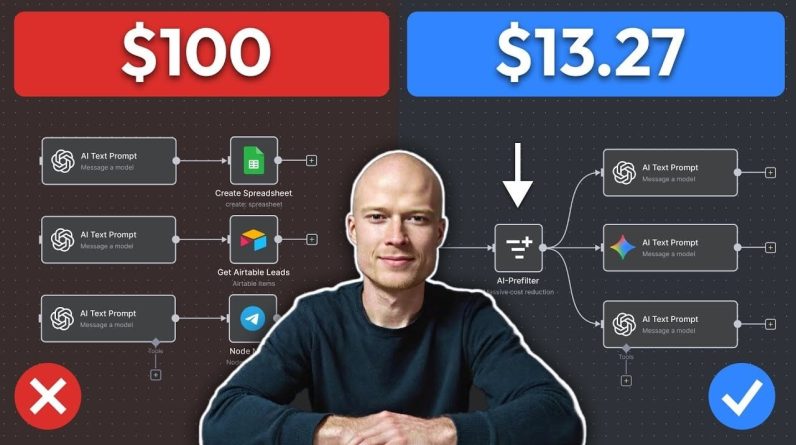
Imagine this: your AI-powered workflow is running smoothly, processing thousands of inputs daily, but the costs are spiraling out of control. Advanced models like GPT-5 or Google Gemini 2.5 Pro are incredible at what they do, but they’re also notoriously expensive. What if you could slash those costs by a staggering 87% without sacrificing quality? It’s not just wishful thinking. By implementing a clever technique called pre-filtering, you can stop wasting resources on unnecessary tasks and reserve your high-cost AI systems for the jobs that truly matter. In this instructional feature, we’ll uncover how this simple yet fantastic method can transform your automation strategy.
In this guide by Mike Pekka, you’ll discover how pre-filtering works, why it’s such a fantastic option, and how to integrate it into your existing workflows. You’ll explore strategies like input categorization and relevance filtering, which ensure that only high-priority data reaches your expensive AI models. Along the way, we’ll also touch on alternatives like pre-routing and discuss the limitations you need to watch out for. Whether you’re an automation enthusiast or a business leader looking to optimize costs, this tutorial will equip you with actionable insights to make smarter, more efficient use of your AI resources. Sometimes, the smartest solutions are the simplest ones, let’s explore why pre-filtering might be exactly what your workflow needs.
Reducing AI Automation Costs
TL;DR Key Takeaways :
- AI automation offers efficiency and scalability but can lead to high operational costs when advanced models are used indiscriminately for all tasks.
- Pre-filtering is a cost-saving technique that uses low-cost AI models to filter out irrelevant or low-priority data before sending critical inputs to high-cost models.
- Implementing pre-filtering can reduce AI automation costs by up to 70% or more, as demonstrated in a hypothetical cost analysis example.
- Effective pre-filtering strategies include input categorization, source validation, and input type filtering to ensure accurate and efficient processing.
- Pre-routing is an alternative to pre-filtering, directing simpler tasks to medium-cost models while reserving high-cost models for complex tasks, further optimizing resource allocation.
The Cost Challenges of AI Automation
AI automation delivers unparalleled capabilities, but its implementation is not without challenges. High-performance AI models are resource-intensive and expensive to operate. When these advanced systems are used for every task, regardless of complexity, they generate unnecessary expenses. For instance, straightforward tasks like sorting data or categorizing inputs do not require the sophistication of top-tier AI models. Over-reliance on these systems results in inefficiencies, inflating operational costs and diminishing the overall return on investment.
To address these challenges, organizations must adopt smarter strategies that balance cost and performance. Pre-filtering is one such approach that enables businesses to maximize the value of their AI investments while minimizing waste.
What Is Pre-Filtering?
Pre-filtering is a cost-saving technique designed to optimize AI workflows. Instead of directing all inputs to an advanced, high-cost AI model, a low-cost model is employed as an intermediary step. This model filters out irrelevant or low-priority data, making sure that only the most critical inputs are processed by the expensive AI system. By reducing the workload on high-cost models, pre-filtering not only cuts expenses but also enhances resource efficiency without compromising the quality of results.
This method is particularly effective in scenarios where input data varies widely in relevance or complexity. By introducing a filtering layer, businesses can allocate their resources more strategically, making sure that high-cost models are reserved for tasks that truly require their capabilities.
Optimizing Automations and Cutting AI Costs Using Pre-Filtering
Here are more detailed guides and articles that you may find helpful on AI Automation costs.
How Pre-Filtering Works
The pre-filtering process is straightforward yet highly impactful. It involves three key steps:
- Initial Input Analysis: A low-cost AI model evaluates incoming data to determine its relevance or priority.
- Relevance Filtering: Irrelevant or low-value inputs are excluded, leaving only high-priority data for further processing.
- Advanced Processing: The filtered data is sent to a high-cost AI model for detailed analysis or execution.
For example, consider an AI-powered content curation system for a technology-focused newsletter. A low-cost model can filter out unrelated topics, such as sports or entertainment, making sure that only relevant content reaches the advanced model for final curation. This approach not only saves time but also reduces operational costs significantly.
Quantifying the Cost Savings
The financial benefits of pre-filtering are substantial. To illustrate, let’s examine a hypothetical scenario:
- Without Pre-Filtering: Processing 1,000 inputs with a high-cost AI model costs $1 per input, resulting in a total expense of $1,000.
- With Pre-Filtering: A low-cost model processes all 1,000 inputs at $0.10 per input, filtering out 80% of the data. The remaining 20% (200 inputs) are sent to the high-cost model at $1 per input. The total cost is $100 (low-cost model) + $200 (high-cost model), amounting to $300, a 70% reduction in costs.
This example highlights how pre-filtering can transform AI automation into a more cost-effective and sustainable solution.
Key Strategies for Effective Pre-Filtering
The success of pre-filtering depends on implementing robust techniques to ensure accurate and efficient filtering. Consider the following strategies:
- Input Categorization: Organize data into categories based on relevance, such as high-priority versus low-priority inputs, to streamline filtering.
- Source Validation: Evaluate the credibility and origin of data to ensure that only reliable inputs are processed further.
- Input Type Filtering: Exclude irrelevant formats, such as spam or outdated documents, to maintain a focused workflow.
These strategies not only enhance the efficiency of pre-filtering but also ensure that high-cost models are used for tasks that truly require their advanced capabilities.
Pre-Routing: An Alternative Approach
In some workflows, discarding inputs entirely may not be feasible. Pre-routing offers an alternative solution. Instead of eliminating data, this method directs simpler tasks to medium-cost models while reserving high-cost models for more complex tasks.
For instance, in a customer support system, routine inquiries can be handled by a medium-cost AI model, while more intricate issues are escalated to a high-cost AI. This approach ensures that all inputs are processed appropriately while still reducing overall expenses.
Customization and Limitations
While pre-filtering is a powerful tool, it is not universally applicable. Its effectiveness depends on tailoring the approach to your specific workflow. For processes with clear relevance criteria, pre-filtering is highly effective. However, workflows requiring comprehensive input analysis may benefit more from pre-routing or other strategies.
Additionally, the accuracy of the low-cost model used for filtering is critical. An unreliable filtering layer can lead to errors, such as discarding valuable inputs or forwarding irrelevant data to high-cost models. Investing in a reliable intermediate AI layer is essential to achieving optimal results.
Optimizing AI Automation with Pre-Filtering
Pre-filtering represents a practical and efficient way to reduce AI automation costs while maintaining high-quality outcomes. By integrating low-cost AI models into your workflow, you can filter out irrelevant data, optimize resource allocation, and achieve significant savings. Whether through pre-filtering or pre-routing, this approach emphasizes the importance of customizing AI workflows to balance efficiency and effectiveness. By adopting these strategies, businesses can unlock the full potential of AI automation while staying within budget.
Media Credit: Mike Pekka | AI Automation
Filed Under: AI, Guides
Latest Geeky Gadgets Deals
If you buy something through one of these links, Geeky Gadgets may earn an affiliate commission. Learn about our Disclosure Policy.
Originally Appeared Here








